Calcareous Skarn-like Mineral Paragenesis from Unaltered Basalt of the Alaid Volcano (Kuril–Kamchatka Island Arc)
Abstract
1. Introduction
2. Geological Setting
3. Materials and Methods
3.1. Materials
3.2. Methods
3.2.1. Scanning Electron Microscopy and Electron–Microprobe Analysis of Unpolished Grains
3.2.2. Scanning Electron Microscopy and Electron–Microprobe Analysis of Polished Grains
3.2.3. Powder X-Ray Diffraction
3.2.4. Single-Crystal X-Ray Diffraction
4. Results
4.1. Powder X-Ray Diffraction
4.2. Scanning Electron Microscopy and Electron–Microprobe Analysis
4.3. Crystal Structures
5. Discussion
6. Conclusions
Supplementary Materials
Author Contributions
Funding
Data Availability Statement
Acknowledgments
Conflicts of Interest
References
- Markhinin, E.K. Volcanism as an agent of formation of the Earth’s crust. Crust Up. Mantle Pac. Area 2012, 12, 413–422. [Google Scholar]
- Martin, A.P.; Cooper, A.F.; Price, R.C.; Doherty, C.L.; Gamble, J.A. A review of mantle xenoliths in volcanic rocks from southern Victoria Land, Antarctica. Geochem. Geophys. Antarct. Mantle 2023, 56, 33–55. [Google Scholar] [CrossRef]
- Rodríguez, A.; van Bergen, M.J. Superficial alteration mineralogy in active volcanic systems: An example of Poás volcano, Costa Rica. J. Volcanol. Geoth. Res. 2017, 346, 54–80. [Google Scholar] [CrossRef]
- Sillitoe, R.H.; Bonham, H.F. Volcanic landforms and ore deposits. Econ. Geol. 1984, 79, 1286–1298. [Google Scholar] [CrossRef]
- Hedenquist, J.W.; Lowenstern, J.B. The role of magmas in the formation of hydrothermal ore deposits. Nature 1994, 370, 519–527. [Google Scholar] [CrossRef]
- Campeny, M.; Menéndez, I.; Ibáñez-Insa, J.; Rivera-Martínez, J.; Yepes, J.; Álvarez-Pousa, S.; Méndez-Ramos, J.; Mangas, J. The ephemeral fumarolic mineralization of the 2021 Tajogaite volcanic eruption (La Palma, Canary Islands, Spain). Sci. Rep. 2023, 13, 6336. [Google Scholar] [CrossRef] [PubMed]
- Shchipalkina, N.V.; Pekov, I.V.; Koshlyakova, N.N.; Belakovskiy, D.I.; Zubkova, N.V.; Agakhanov, A.A.; Britvin, S.N.; Nazarova, M.A. A new mineral cuprodobrovolskyite Na4Cu(SO4)3 from the Tolbachik volcano (Kamchatka, Russia) and relationships in the family of natural anhydrous Na–Cu sulfates. Mineral. Mag. 2024, 88, 49–60. [Google Scholar] [CrossRef]
- Borisov, A.S.; Siidra, O.I.; Vlasenko, N.S.; Platonova, N.V.; Schuldt, T.; Neuman, M.; Strauss, H.; Holzheid, A. The Yadovitaya fumarole, Tolbachik volcano: A comprehensive mineralogical and geochemical study and driving factors for mineral diversity. Geochemistry 2024, 84, 126179. [Google Scholar] [CrossRef]
- Balić-Žunić, T.; Nestola, F.; Pamato, M.G.; Rasmussen, M.B. Kristjánite, KNa2H(SO4)2, a new fumarolic mineral from Iceland containing the [SO4–H–SO4]3– anion in the crystal structure. Mineral. Mag. 2024, 88, 211–217. [Google Scholar] [CrossRef]
- Renggli, C.J.; Klemme, S. Experimental constraints on metal transport in fumarolic gases. J. Volcanol. Geoth. Res. 2020, 400, 106929. [Google Scholar] [CrossRef]
- Vander Auwera, J.; Montalbano, S.; Namur, O.; Bechon, T.; Schiano, P.; Devidal, J.L.; Bolle, O. The petrology of a hazardous volcano: Calbuco (Central Southern Volcanic Zone, Chile). Contrib Mineral Petrol. 2021, 176, 46. [Google Scholar] [CrossRef]
- Grapes, R. Pyrometamorphism, 2nd ed.; Springer-Verlag Berlin: Heidelberg, Germany, 2011; p. 365. [Google Scholar]
- Galuskina, I.O.; Krüger, B.; Galuskin, E.V.; Armbruster, T.; Gazeev, V.M.; Włodyka, R.; Dulski, M.; Dzierżanowski, P. Fluorchegemite, Ca7(SiO4)3F2, a new mineral from the edgrewite-bearing endoskarn zone of an altered xenolith in ignimbrites from upper Chegem caldera, northern Caucasus, Kabardino-Balkaria, Russia: Occurrence, crystal structure, and new data on the mineral assemblages. Canad Miner. 2015, 53, 325–344. [Google Scholar]
- Zubkova, N.V.; Chukanov, N.V.; Pekov, I.V.; Ternes, B.; Schüller, W.; Pushcharovskii, D.Y. Ta-Free Nb-Dominant Ixiolite Analogue from the Eifel Paleovolcanic Region, Germany, and Its Crystal Structure. On the Problem of “Ashanite”. Geol. Ore Depos. 2021, 63, 805–811. [Google Scholar] [CrossRef]
- Pekov, I.V.; Agakhanov, A.A.; Zubkova, N.V.; Koshlyakova, N.N.; Shchipalkina, N.V.; Sandalov, F.D.; Yapaskurt, V.O.; Turchkova, A.G.; Sidorov, E.G. Oxidizing-type fumaroles of the Tolbachik Volcano, a mineralogical and geochemical unique. Russ. Geol. Geophys. 2020, 61, 675–688. [Google Scholar] [CrossRef]
- Garavelli, A.; Pinto, D.; Mitolo, D.; Kolitsch, U. Thermessaite-(NH4), (NH4)2AlF3 (SO4), a new fumarole mineral from La Fossa crater at Vulcano, Aeolian Islands, Italy. Mineral. Mag. 2021, 85, 665–672. [Google Scholar] [CrossRef]
- Balassone, G.; Panikorovskii, T.L.; Pellino, A.; Bazai, A.V.; Bocharov, V.N.; Goychuk, O.F.; Avdontseva, E.Y.; Yakovenchuk, V.N.; Krivovichev, S.V.; Petti, C.; et al. Enricofrancoite, KNaCaSi4O10, a new Ca–K–Na silicate from Somma–Vesuvius volcano, southern Italy. Mineral. Mag. 2024, 88, 277–287. [Google Scholar] [CrossRef]
- Campostrini, I.; Castellano, C.; Demartin, F.; Rocchetti, I.; Russo, M.; Vignola, P. Paradimorphite, β-As4S3, a vintage new mineral from Solfatara di Pozzuoli and Vesuvius, Napoli, Italy. Mineral. Mag. 2022, 86, 500–506. [Google Scholar] [CrossRef]
- Kasatkin, A.V.; Siidra, O.I.; Nestola, F.; Pekov, I.V.; Agakhanov, A.A.; Koshlyakova, N.N.; Chukanov, N.V.; Nazarchuk, E.V.; Molinari, S.; Rossi, M. Napoliite, Pb2OFCl, a new mineral from Vesuvius volcano, and its relationship with dimorphous rumseyite. Mineral. Mag. 2023, 87, 711–718. [Google Scholar] [CrossRef]
- Balić-Žunić, T.; Garavelli, A.; Jakobsson, S.P.; Jonasson, K.; Katerinopoulos, A.; Kyriakopoulos, K.; Acquafredda, P. Fumarolic minerals: An overview of active European volcanoes. In Updates in Volcanology-From Volcano Modelling to Volcano Geology; Nemeth, K., Ed.; IntechOpen Limited: London, UK, 2016; pp. 267–322. [Google Scholar]
- Gorshkov, G.S. Volcanism of the Kuril Island Arc; Nauka: Moscow, Russia, 1967; 288p. (In Russian) [Google Scholar]
- Martynov, Y.A.; Martynov, A.Y.; Chashchin, A.A.; Rybin, A.V. Basalts of Tyatya volcano: Petrology and genesis (Kunashir Island, Kuril Island Arc). Russ. J. Pac. Geol. 2005, 24, 22–31. [Google Scholar]
- Blokh, Y.I.; Bondarenko, V.I.; Rashidov, V.A.; Trusov, A.A. The Alaid Volcanic Massif (Kuril Island-Arc System). In Proceedings of the International Symposium “Problems of Modern Volcanism”; Institute of volcanology and seismology FEB RAS: etropavlovsk-Kamchatsky, Russian, 2006; pp. 135–143. (In Russian) [Google Scholar]
- Bolshakov, I.E.; Nuzhdaev, A.A.; Kuznetsov, R.A.; Anikin, L.P.; Kudryashova, K.A.; Zhitova, E.S. Expedition to Alaid and Ebeko Volcanoes (Kuril Islands) in Summer 2023. Bull. Krasec. Earth Sci. 2023, 4, 105–113. (In Russian) [Google Scholar] [CrossRef]
- Degterev, A.V.; Chibisova, M.V.; Romanyuk, F.A. An Explosive–Effusive Eruption of Alaid Volcano in 2022 (Atlasova Island, Northern Kuril Islands). Russ. J. Pac. Geol. 2023, 17 (Suppl. S2), S249–S258. [Google Scholar] [CrossRef]
- Didenko, A.H.; Rashidov, V.A.; Markov, G.P.; Trusenko, M.S.; Petrova, V.V.; Anikin, L.P. Petromagnetic and geochemical characterization of volcanics from the 2015-2016 eruption of Alaid volcano, Kuril Island Arc. J. Volcanol. Seismol. 2021, 1, 3–21. (In Russian) [Google Scholar]
- Fedotov, S.A.; Ivanov, B.V.; Avdeiko, G.P.; Flerov, G.P.; Andreyev, V.N.; Dvigalo, V.N.; Dubik, Y.M.; Chirkov, A.M. Eruption of Alaid Volcano in 1981. J. Volcanol. Seismol. 1981, 5, 82–87. (In Russian) [Google Scholar]
- Avdeiko, G.P.; Khrenov, A.P.; Flerov, G.B.; Tokarev, P.I.; Shirokov, V.A.; Meniaylov, I.A.; Chirkov, A.M.; Volinets, O.N.; Dubik, Y.M.; Vergasova, L.P.; et al. Eruption of Alaid volcano in 1972. Bull. Volconological Stn. 1974, 50, 64–80. (In Russian) [Google Scholar]
- Abdurakhmanov, B.N.; Piskunov, I.G.; Smirnov, I.G.; Fedorchenko, V.I. Alaid volcano (Kuril Islands). In East Asian Island Systems (Tectonics and Volcanism); Tuezov, I.K., Ed.; SakhKNII: Yuzhno-Sakhalinsk, Russia, 1978; pp. 85–107. (In Russian) [Google Scholar]
- Bergal-Kuvikas, O.V. Peculiarities of the spatial variations from Paramushir volcanic Group, Kurile Islands. Arc. Bull. Krasec. Earth Sci. 2012, 20, 194–207. (In Russian) [Google Scholar]
- Geodekyan, A.A.; Udintsev, G.B.; Baranov, B.V.; Beresnev, A.F.; Burk, C.; Bogatikov, O.A.; Gabov, V.V.; Gnibidenko, G.S.; Dmitriyev, Y.I.; Zonenshayn, L.P.; et al. Solid rocks of the floor of the central part of the Sea of Okhotsk. Int. Geol. Rev. 1977, 19, 817–834. [Google Scholar] [CrossRef]
- Vasiliev, B.; Putintsev, V.K.; Markovsky, V.; Svyatogorova, N.; Selivanov, V.; Udintsev, G. Results of dragging the bottom of the Sea of Okhotsk. Sov. Geol. 1984, 12, 100–107. [Google Scholar]
- Zhitova, E.S.; Anikin, L.P.; Sergeeva, A.V.; Ismagilova, R.M.; Rashidov, V.A.; Chubarov, V.M.; Kupchinenko, A.N. Volborthite Occurrence at the Alaid Volcano (Atlasov Island, Kuril Islands, Russia). Geol. Ore Depos. 2021, 63, 735–748. [Google Scholar] [CrossRef]
- Britvin, S.N.; Dolivo-Dobrovolsky, D.V.; Krzhizhanovskaya, M.G. Software for processing of X-ray powder diffraction data obtained from the curved image plate detector of Rigaku RAXIS Rapid II diffractometer. Zapiski RMO 2017, 146, 104–107. (In Russian) [Google Scholar]
- Bruker-AXS Topas. General Profile and Structure Analysis Software for Powder Diffraction Data, Version 4.2; Bruker-AXS: Karlsruhe, Germany, 2009.
- CrysAlisPro Software System, Version 1.171.39.44; Rigaku Oxford Diffraction: Oxford, UK, 2015.
- Sheldrick, G.M. Crystal Structure Refinement with It SHELXL. Acta Crystallogr. C 2015, 71, 3–8. [Google Scholar] [CrossRef] [PubMed]
- Dolomanov, O.V.; Bourhis, L.J.; Gildea, R.J.; Howard, J.A.K.; Puschmann, H. It OLEX2: A Complete Structure Solution, Refinement and Analysis Program. J. Appl. Crystallogr. 2009, 42, 339–341. [Google Scholar] [CrossRef]
- Cameron, M.; Sueno, S.; Prewitt, C.T.; Papike, J.J. High-Temperature Crystal Chemistry of Acmite, Diopside, Hedenbergite Jadeite, Spodumene and Ureyite. Am. Mineral. 1973, 58, 594–618. [Google Scholar]
- Quartieri, S.; Oberti, R.; Boiocchi, M.; Dalconi, M.C.; Boscherini, F.; Safonova, O.; Woodland, A.B. Site preference and local geometry of Sc in garnets: Part II. The crystal-chemistry of octahedral Sc in the andradite–Ca3Sc2Si3O12 join. Am. Mineral. 2006, 91, 1240–1248. [Google Scholar] [CrossRef]
- Klein, S.; Korekawa, M. Die gemittelte Struktur des Labradorits. Neues Jahrb. Fur Mineral. Monatshefte 1976, 1976, 66–69. [Google Scholar]
- Speziale, S.; Duffy, T.S. Single-crystal elastic constants of fluorite (CaF2) to 9.3 GPa. Phys. Chem. Miner. 2002, 29, 465–472. [Google Scholar] [CrossRef]
- Graf, D.L. Crystallographic tables for the rhombohedral carbonates. Am. Mineral. 1961, 46, 1283–1316. [Google Scholar]
- Grew, E.S.; Hålenius, U.; Pasero, M.; Barbier, J. Recommended nomenclature for the sapphirine and surinamite groups (sapphirine supergroup). Mineral. Mag. 2008, 72, 839–876. [Google Scholar] [CrossRef]
- Zolotarev, A.A.; Krivovichev, S.V.; Avdontceva, M.S.; Zhitova, E.S.; Shchipalkina, N.V.; Pekov, I.V. Crystal Chemistry of “Malakhovite”, an Anthropogenic Analog of Khesinite from Burnt Dumps of the Chelyabinsk Coal Basin (South Urals). Crystallogr. Rep. 2021, 66, 66–75. [Google Scholar] [CrossRef]
- Peretyazhko, I.S.; Savina, E.A.; Khromova, E.A. Minerals of the rhönite-kuratite series in paralavas from a new combustion metamorphic complex in the Choir–Nyalga basin (Central Mongolia): Composition, mineral assemblages and formation conditions. Mineral. Mag. 2017, 81, 949–974. [Google Scholar] [CrossRef]
- Galuskin, E.V.; Krüger, B.; Krüger, H.; Blass, G.; Widmer, R.; Galuskina, I.O. Wernerkrauseite, CaFe3+2Mn4+O6: The first nonstoichiometric post-spinel mineral, from Bellerberg volcano, Eifel, Germany. EJM 2016, 28, 485–493. [Google Scholar] [CrossRef]
- Knuever, M.; Mele, D.; Sulpizio, R. Mineralization and Skarn Formation Associated with Alkaline Magma Chambers Emplaced in a Limestone Basement: A Review. Minerals 2023, 13, 1184. [Google Scholar] [CrossRef]
- Reato, L.; Huraiová, M.; Ackerman, L.; Ďurišová, J.; Horschinegg, M.; Konečný, P.; Meicel, T.C.; Hurai, V. Forearc magmatism in the Pannonian basin recorded by metasomatised skarnoid xenoliths in Pliocene basalt (Novohrad-Gemer Volcanic Field, Slovakia). Lithos 2024, 482, 107741. [Google Scholar] [CrossRef]
- Davydova, V.O.; Shcherbakov, V.D.; Nekrylov, N.A.; Plechov, P.Y.; Yapaskurt, V.O. Sulfide Mineralization in Pyrometamorphosed Upper Crustal Xenoliths, Bezymianny Volcano, Kamchatka. Petrology 2023, 31, 358–382. [Google Scholar] [CrossRef]
- Shchipalkina, N.V.; Pekov, I.V.; Koshlyakova, N.N.; Britvin, S.N.; Zubkova, N.V.; Varlamov, D.A.; Sidorov, E.G. Unusual silicate mineralization in fumarolic sublimates of the Tolbachik volcano, Kamchatka, Russia–Part 1: Neso-, cyclo-, ino-and phyllosilicates. EJM 2020, 32, 101–119. [Google Scholar]
- Shchipalkina, N.V.; Pekov, I.V.; Koshlyakova, N.N.; Britvin, S.N.; Zubkova, N.V.; Varlamov, D.A.; Sidorov, E.G. Unusual silicate mineralization in fumarolic sublimates of the Tolbachik volcano, Kamchatka, Russia–Part 2: Tectosilicates. EJM 2020, 32, 121–136. [Google Scholar]
- Ganino, C.; Libourel, G.; Bernard, A. Fumarolic incrustations at Kudryavy volcano (Kamchatka) as a guideline for high-temperature (>850 C) extinct hydrothermal systems. J. Volcanol. Geoth. Res. 2019, 376, 75–85. [Google Scholar] [CrossRef]
- Chebotarev, D.A.; Veksler, I.V.; Wohlgemuth-Ueberwasser, C.; Doroshkevich, A.G.; Koch-Müller, M. Experimental study of trace element distribution between calcite, fluorite and carbonatitic melt in the system CaCO3 + CaF2 + Na2CO3 ± Ca3(PO4)2 at 100 MPa. Contrib. Mineral. Petrol. 2018, 174, 4. [Google Scholar] [CrossRef]
- Gozzi, F.; Gaeta, M.; Freda, C.; Mollo, S.; Di Rocco, T.; Marra, F.; Dallai, L.; Pack, A. Primary magmatic calcite reveals origin from crustal carbonate. Lithos 2014, 190–191, 191–203. [Google Scholar] [CrossRef]
- Veksler, I.V.; Dorfman, A.M.; Dulski, P.; Kamenetsky, V.S.; Danyushevsky, L.V.; Jeffries, T.; Dingwell, D.B. Partitioning of elements between silicate melt and immiscible fluoride, chloride, carbonate, phosphate and sulfate melts, with implications to the origin of natrocarbonatite. Geochim. Cosmochim. Acta 2012, 79, 20–40. [Google Scholar] [CrossRef]
- Vapnik, Y.; Sokol, E.; Murashko, M.; Sharygin, V. The enigma of Hatrurim. Mineral. Alm. 2006, 10, 69–77. [Google Scholar]
- Kruszewski, Ł.; Palchik, V.; Vapnik, Y.; Nowak, K.; Banasik, K.; Galuskina, I. Mineralogical, Geochemical, and Rock Mechanic Characteristics of Zeolite-Bearing Rocks of the Hatrurim Basin, Israel. Minerals 2021, 11, 1062. [Google Scholar] [CrossRef]
- Stracher, G.B. (Ed.) Coal and Peat Fires: A Global Perspective: Volume 5: Case Studies–Advances in Field and Laboratory Research; Elsevier: Amsterdam, The Netherlands, 2018. [Google Scholar]
- Cesnokov, B.; Kotrly, M.; Nisanbajev, T. Brennende Abraumhalden und Aufschlüsse im Tscheljabinsker Kohlenbecken–eine reiche Mineralienküche [Burning tailings and outcrops in the Chelyabinsk coal basin–a rich mineral kitchen]. Miner. Welt 1998, 9, 54–63. [Google Scholar]
- Yakubovich, O.V.; Zayakina, N.V.; Oleinikov, O.B.; Kostin, A.V. Esseneite from xenoliths in dacite lavas: Crystal structure and genesis. Geol. Ore Depos. 2019, 61, 689–695. [Google Scholar] [CrossRef]
- Ciesielczuk, J.; Kruszewski, Ł.; Majka, J. Comparative mineralogical study of thermally-altered coal-dump waste, natural rocks and the products of laboratory heating experiments. Int. J. Coal Geol. 2015, 139, 114–141. [Google Scholar] [CrossRef]
- Cosca, M.A.; Rouse, R.R.; Essene, E.J. Dorrite [Ca2(Mg2Fe3+)4(Al4Si2)O20], a new member of the aenigmatite group from a pyrometamorphic melt-rock. Am. Min. 1988, 73, 1440–1448. [Google Scholar]
- Pascal, M.; Katona, I.; Fonteilles, M.; Verkaeren, J. Relics of high-temperature clinopyroxene on the join Di-CaTs with up to 72 mol.% Ca (Al, Fe3+) AlSiO6 in the skarns of Ciclova and Magureaua Vatei, Carpathians, Romania. Can. Miner. 2005, 43, 857. [Google Scholar] [CrossRef]
- Havette Ledebt, A.; Clocchiatti, R.; Nativel, P.; Montaggioni, L. Une paragenèse inhabituelle à fassaite, mélilite et rhönite dans un basalte alcalin contaminé au contact d’un récif corallien (Saint-Leu, Ile de la Réunion). Bull. De Minéralogie 1982, 105, 364–375. [Google Scholar] [CrossRef]
- Arculus, R.J.; Wills, K.J. The petrology of plutonic blocks and inclusions from the Lesser Antilles island arc. J. Petrol. 1980, 21, 743–799. [Google Scholar] [CrossRef]
- Cosca, M.A.; Peacor, D.R. Chemistry and structure of esseneite (CaFe3+AlSiO6); a new pyroxene produced by pyrometamorphism. Am. Min. 1987, 72, 148–156. [Google Scholar]
- Clark, J.A.; Appleman, D.E.; Papike, J.J. Crystal-chemical characterization of clinopyroxenes based on eight new structure refinements. Mineral. Soc. Amer. Spec. 1969, 2, 31–50. [Google Scholar]
- Kimura, M.; Mikouchi, T.; Suzuki, A.; Miyahara, M.; Ohtani, E.; El Goresy, A. Kushiroite, CaAlAlSiO6: A new mineral of the pyroxene group from the ALH 85085 CH chondrite, and its genetic significance in refractory inclusions. Am. Min. 2009, 94, 1479–1482. [Google Scholar] [CrossRef]
- Shchipalkina, N.V.; Pekov, I.V.; Chukanov, N.V.; Koshlyakova, N.N.; Ternes, B.; Schüller, W. Crystal chemistry of dorrite from the Eifel volcanic region, Germany, and chemical variations in the khesinite-dorrite-rhönite-kuratite solid-solution system. Mineral. Petrol. 2019, 113, 249–259. [Google Scholar] [CrossRef]
- Kong, F.-M.; Schertl, H.-P.; Zhao, L.-Q.; Li, X.-P.; Liu, X.-H. Rhönite in Cenozoic alkali basalt from Changle, Shandong Province, China, and its significance. EJM 2020, 32, 325–346. [Google Scholar] [CrossRef]
- Nizametdinov, I.R.; Smirnov, S.Z.; Shevko, A.Y.; Kuzmin, D.V.; Kotov, A.A.; Sekisova, V.S.; Timina, T.Y. High-Alumina Daughter Phases in Olivine-Hosted Melt Inclusions from Kudryavy and Menshiy Brat Volcanoesv (Medvezhia Caldera, Iturup Island). Russ. J. Pac. Geol. 2024, 18, 410–435. [Google Scholar] [CrossRef]
- Kunzmann, T. The aenigmatite-rhonite mineral group. EJM 1999, 11, 743–756. [Google Scholar] [CrossRef]
- Tsukimura, K.; Kanazawa, Y.; Aoki, M.; Bunno, M. Structure of wadalite Ca6Al5Si2O16Cl3. Acta Crystallogr. C 1993, 49, 205–207. [Google Scholar] [CrossRef]
- Ma, C.; Krot, A.N.; Nagashima, K.; Dunn, T. Louisfuchsite, Ca2(Mg4Ti2)(Al4Si2)O20, a new rhönite-type mineral from the NWA 4964 CK meteorite: A refractory phase from the solar nebula. Am. Min. 2024, 109, 2006–2012. [Google Scholar] [CrossRef]
- Sharygin, V.V. Mayenite-supergroup minerals from burned dump of the Chelyabinsk Coal Basin. Russ. Geol. Geophys. 2015, 56, 1603–1621. [Google Scholar] [CrossRef]
- Banno, Y.; Bunno, M.; Tsukimura, K. A reinvestigation of holotype wadalite from Tadano, Fukushima Prefecture, Japan. Mineral. Mag. 2018, 82, 1023–1031. [Google Scholar] [CrossRef]
- Whitley, S.; Halama, R.; Gertisser, R.; Preece, K.; Deegan, F.M.; Troll, V.R. Magmatic and Metasomatic Effects of Magma–Carbonate Interaction Recorded in Calc-silicate Xenoliths from Merapi Volcano (Indonesia). J. Petrol. 2020, 61, eagga048. [Google Scholar] [CrossRef]
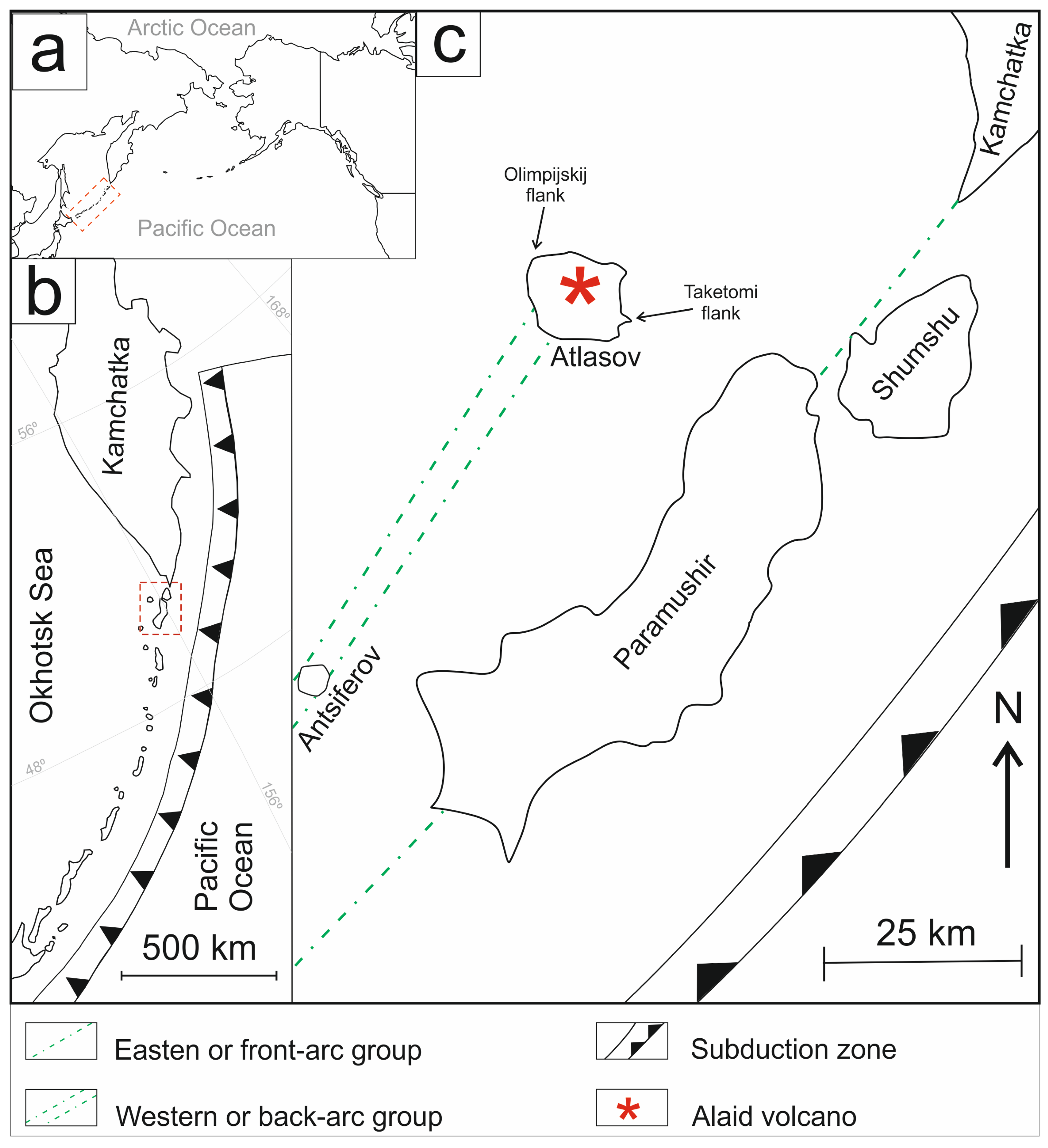

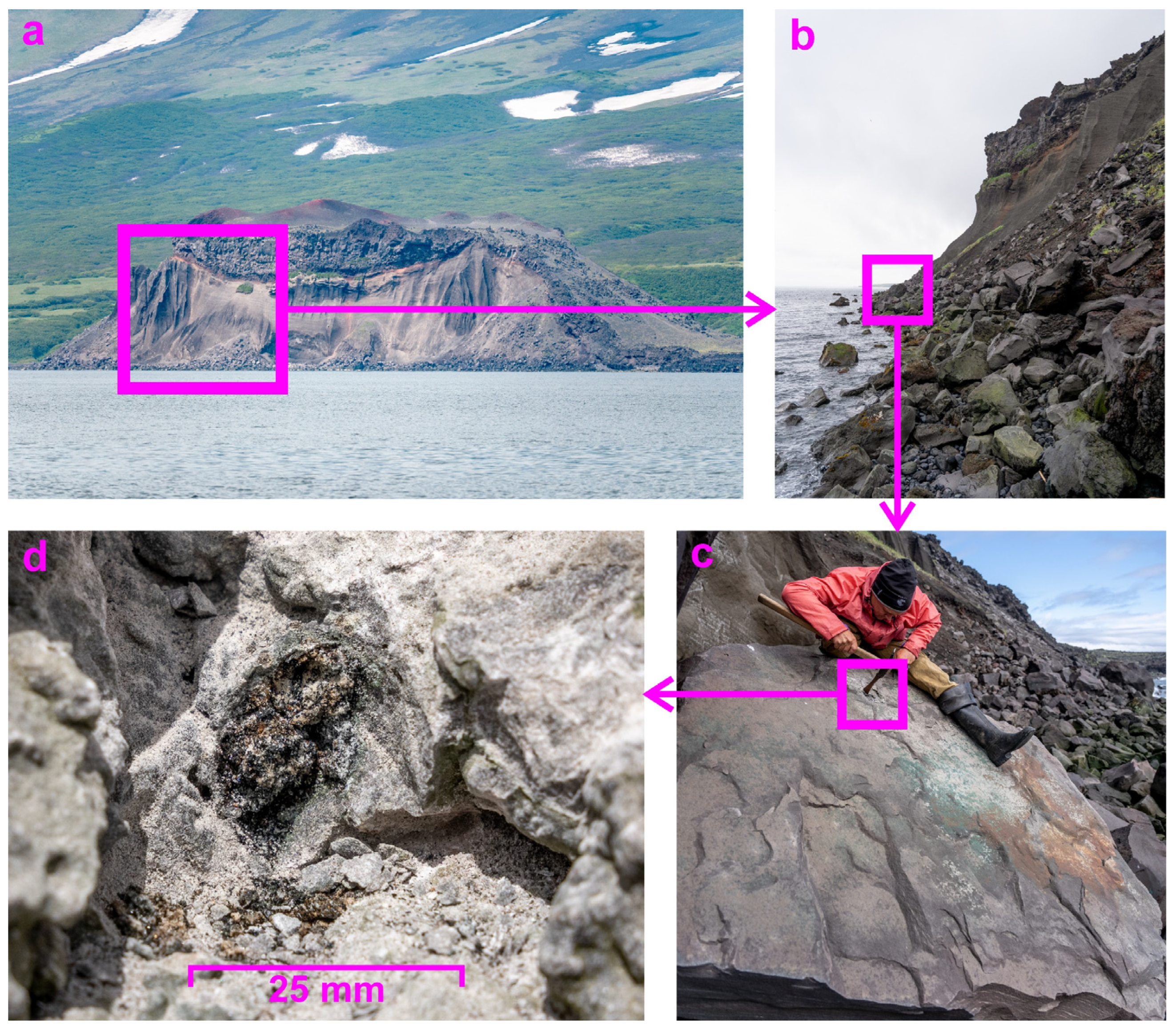

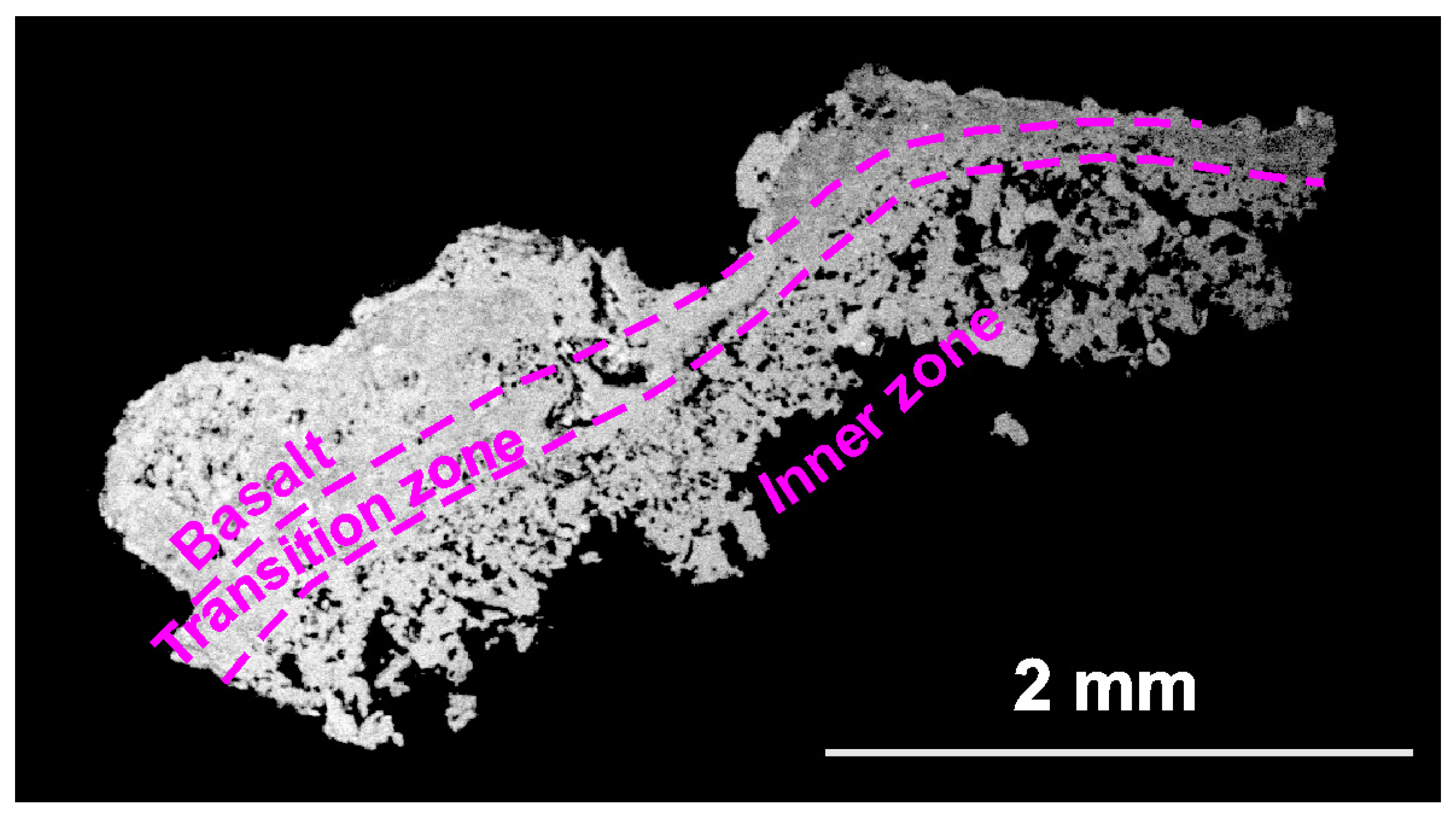



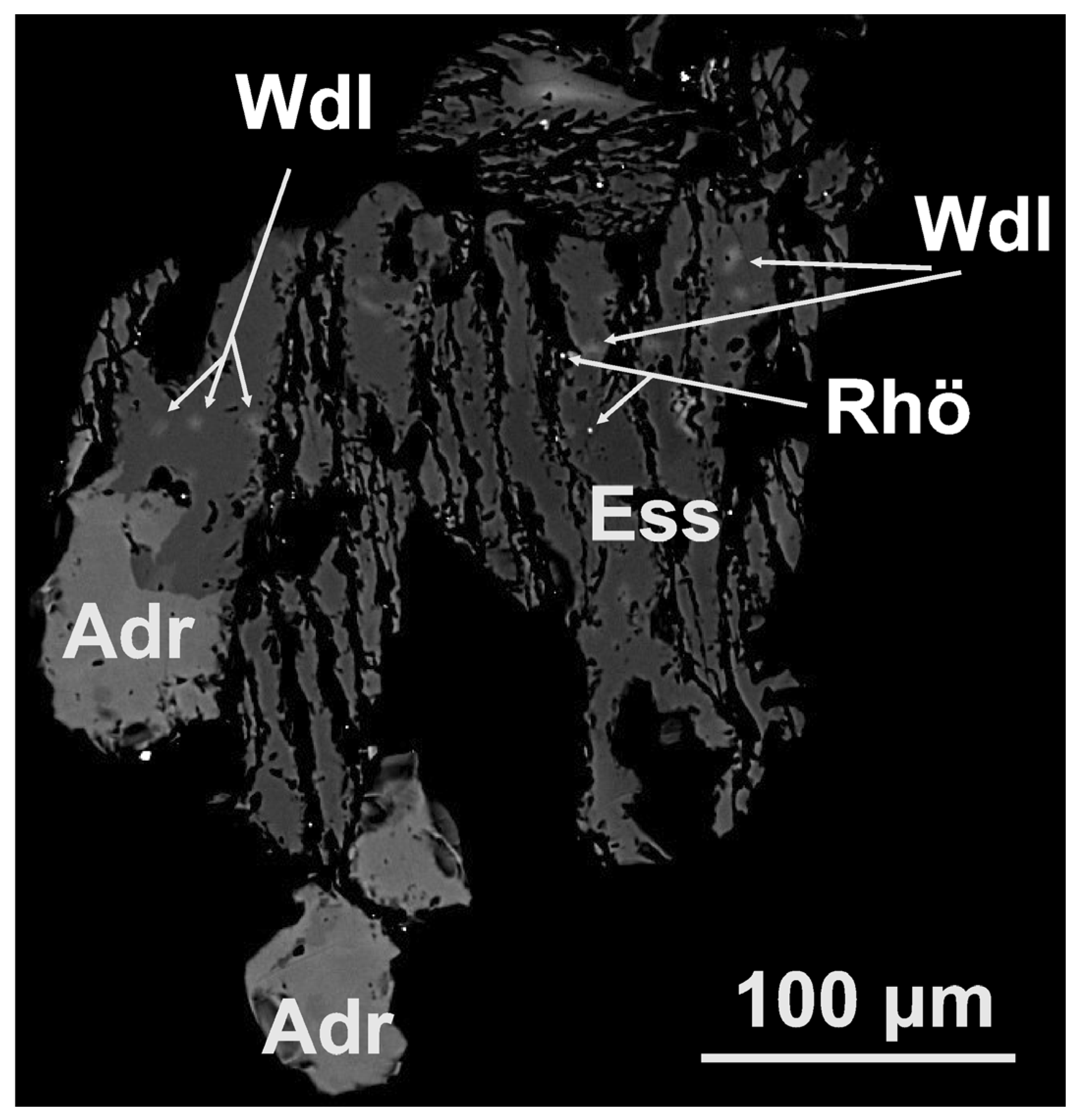

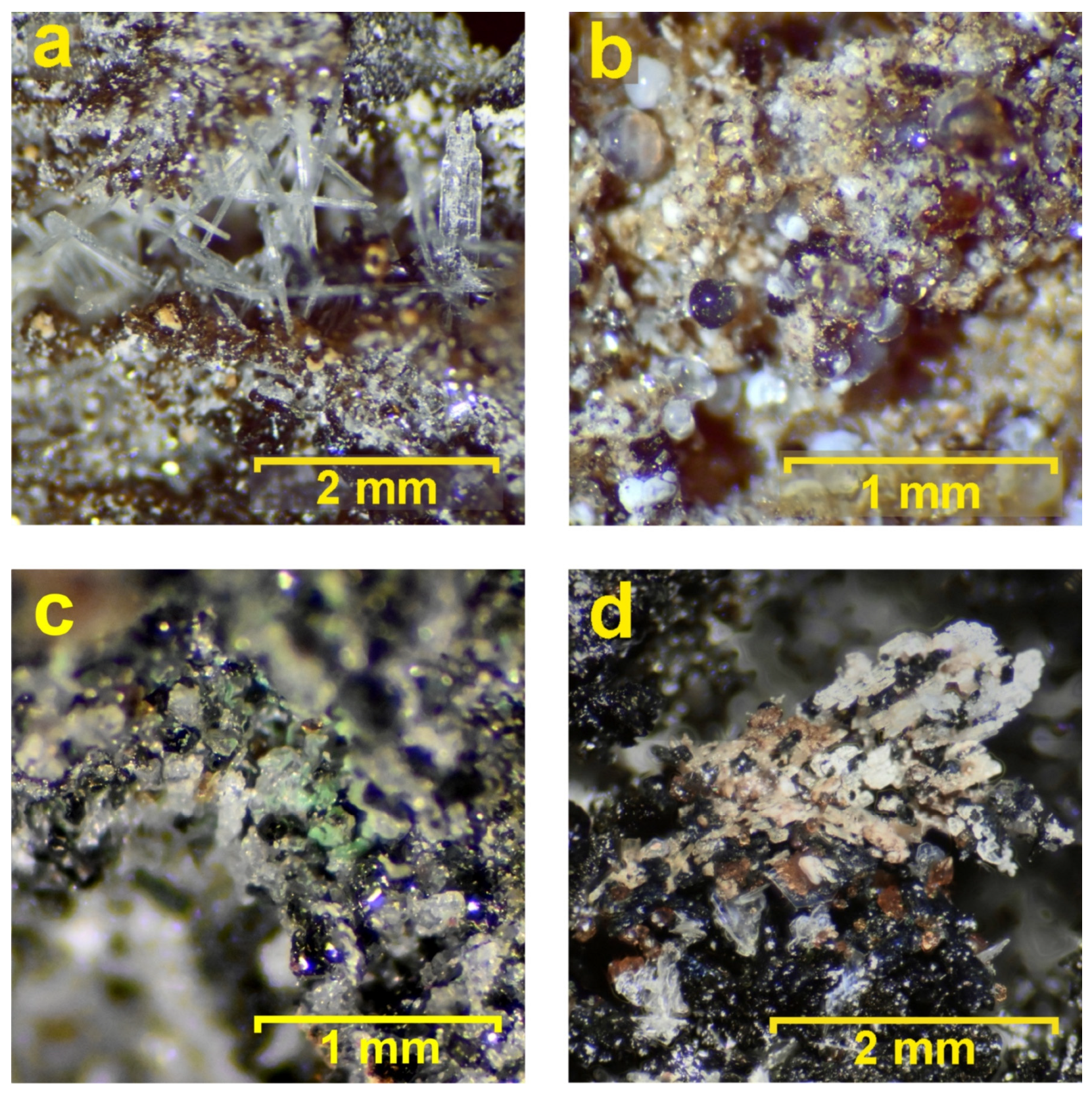
| Structure Type | Clinopyroxene | Garnet | Anorthite | Wollastonite 1 | Fluorite | Calcite |
|---|---|---|---|---|---|---|
| Symmetry | Monoclinic | Cubic | Triclinic | Triclinic | Cubic | Trigonal |
| a (Å) | 9.75–9.79 | 11.96 | 8.19–8.20 | 7.92 | 5.47 | 5.00 |
| b (Å) | 8.87–8.90 | = a | 12.84–12.84 | 7.32 | = a | = a |
| c (Å) | 5.31–5.32 | = a | 14.24–14.25 | 7.07 | = a | 17.09 |
| α (°) | 90 | 90 | 93.6–93.7 | 90.15 | 90 | 90 |
| β (°) | 105.8–105.9 | 90 | 116.6 | 95.22 | 90 | 90 |
| γ (°) | 90 | 90 | 88.92–22.99 | 103.54 | 90 | 120 |
| V (Å3) | 443–446 | 1712 | 1334–1339 | 397 | 164 | 370 |
| Used structural models | [39] | [40] | [41] | Our data | [42] | [43] |
| Fluorapatite | Atacamite 2 | Diopside | Anorthite | Wollastonite | |||
|---|---|---|---|---|---|---|---|
| Constituent | n = 6 | Constituent | n = 11 | Constituent | n = 4 | n = 12 | n = 14 |
| CaO | 49.95 | CuO | 73.14 | Na2O | 1.49 | - | - |
| CuO | 0.43 | ZnO | 2.71 | CaO | 11.55 | 19.81 | 44.69 |
| P2O5 | 39.51 | MnO | 1.55 | MgO | 14.39 | - | 1.26 |
| F | 3.15 | FeO | 0.26 | Al2O3 | 7.17 | 35.91 | - |
| Cl | 0.17 | Cl | 17.54 | SiO2 | 48.30 | 43.56 | 52.36 |
| 3 H2Ocalc | 0.17 | 3 H2Ocalc | 13.19 | FeO | 14.56 | - | - |
| O=Cl2 | −7.92 | Fe2O3 | - | 0.71 | 0.50 | ||
| MnO | 0.50 | - | 0.77 | ||||
| TiO2 | 1.87 | - | - | ||||
| Total | 93.38 | Total | 100.47 | Total | 99.83 | 99.99 | 99.58 |
| apfu calculated based on | |||||||
| (Ca + Cu) = 5 | (Cu + Zn + Mn + Fe) = 2 | Σcations = 4 | Ca = 1 | Ca + Mg = 1 | |||
| Ca | 4.97 | Cu | 1.88 | Na | 0.11 | - | - |
| Cu | 0.03 | Zn | 0.07 | Ca | 0.46 | 1.00 | 0.94 |
| P | 3.11 | Mn | 0.04 | Mg | 0.80 | - | 0.04 |
| F | 0.93 | Fe | 0.01 | Al | 0.31 | 1.99 | - |
| Cl | 0.03 | Cl | 1.01 | Si | 1.80 | 2.05 | 1.03 |
| OH | 0.05 | OH | 3.00 | Fe | 0.45 | 0.03 | 0.01 |
| Mn | 0.02 | - | 0.01 | ||||
| Ti | 0.05 | - | - | ||||
| Constituent (wt. %) | Wollastonite | Anorthite | Diopside | Magnetite | Andradite | Esseneite | Rhönite- Like (3) | Wadalite (4) |
|---|---|---|---|---|---|---|---|---|
| n | 26 | 20 | 34 | 6 | 45 | 75 | 6 | 40 |
| Na2O | - | 4.12 | 0.10 | - | - | - | - | 0.39 |
| MgO | 0.06 | - | 14.31 | 0.30 | 0.24 | 4.39 | 3.36 | 2.49 |
| Al2O3 | - | 28.83 | 2.38 | 3.78 | 10.51 | 14.95 | 12.80 | 17.55 |
| SiO2 | 51.67 | 53.11 | 50.69 | - | 38.58 | 38.11 | 18.50 | 23.86 |
| K2O | - | 0.04 | - | - | - | - | - | - |
| CaO | 45.83 | 12.56 | 19.33 | - | 33.77 | 24.28 | 13.98 | 38.35 |
| TiO2 | - | - | 0.83 | 0.36 | - | 0.46 | 0.77 | - |
| MnO | 0.79 | - | 0.26 | 1.85 | 0.58 | 0.47 | 1.45 | 0.23 |
| FeO (1) | 0.31 | - | 10.36 | 29.98 | 1.43 | 6.58 | 13.41 | 6.14 |
| Fe2O3 (1) | - | 0.05 | 1.80 | 64.62 | 16.47 | 10.40 | 35.71 | - |
| Cl | - | - | - | - | - | - | - | 10.87 |
| F | - | - | - | - | 0.11 | |||
| H2O | - | - | - | - | - | - | - | 0.49 |
| Total | 98.66 | 100.40 | 100.06 | 100.89 | 101.60 | 99.64 | 99.98 | 100.09 |
| apfu (2) | ||||||||
| Na | - | 0.36 | 0.01 | - | - | - | - | 0.10 |
| K | - | 0.04 | - | - | - | - | - | - |
| Mg | - | - | 0.79 | 0.02 | 0.04 | 0.26 | 1.50 | 0.51 |
| Al | - | 1.53 | 0.10 | 0.17 | 0.98 | 0.69 | 4.52 | 2.82 |
| Si | 1.03 | 2.39 | 1.87 | - | 3.04 | 1.49 | 5.54 | 3.25 |
| Ca | 0.98 | 0.60 | 0.77 | - | 2.85 | 1.02 | 4.49 | 5.60 |
| Ti | - | - | 0.02 | 0.01 | - | 0.01 | 0.17 | - |
| Mn2+ | 0.01 | - | 0.01 | 0.06 | 0.04 | 0.02 | 0.37 | 0.02 |
| Fe2+ | 0.01 | - | 0.33 | 0.94 | 0.09 | 0.20 | 3.36 | 0.70 |
| Fe3+ | - | 0.05 | 0.05 | 1.81 | 0.98 | 0.32 | 8.05 | - |
| Cl | - | - | - | - | - | - | - | 2.51 |
| F | - | - | - | - | 0.05 | |||
| OH | - | - | - | - | - | - | - | 0.45 (5) |
| Mineral | Esseneite | Andradite | Wollastonite-1A |
|---|---|---|---|
| Symmetry | Monoclinic | Cubic | Triclinic |
| Space group | I2/a | Ia-3d | P-1 |
| a (Å) | 5.3141(3) | 11.9606(2) | 7.0621(2) |
| b (Å) | 8.8521(4) | = a | 7.31681(14) |
| c (Å) | 9.7484(6) | = a | 7.9176(3) |
| α (°) | 90 | 90 | 103.420(2) |
| β (°) | 105.726(6) | 90 | 95.182(3) |
| γ (°) | 90 | 90 | 90.091(2) |
| V (Å3) | 441.41(4) | 1711.04(9) | 396.21(2) |
| Wollastonite | Anorthite | Diopside | Andradite | Fluorapatite | Eseneite | Rhönite | Wadalite | |
|---|---|---|---|---|---|---|---|---|
| Volcanic fumaroles | ||||||||
| Tolbachik (Kamchatka) | - | + | + | + | + | + | - | - |
| Kudryavy (South Kuril) | + | + | + | + | - | - | - | - |
| Xenolith in volcanic eruption product | ||||||||
| Verkhne-chegemskaya caldera (North Caucasus) | + | - | + | + | + | + | - | + |
| Laahar See volcanic complex (Eifel) | + | + | + | + | + | - | + | - |
| Mineral | Esseneite | Diopside | Kushiroite | ||
| Symmetry | Monoclinic | Monoclinic | Monoclinic | ||
| a (Å) | 9.75–9.79 | 9.79 | 9.76 | 9.75 | 9.61 |
| b (Å) | 8.87–8.90 | 8.82 | 8.82 | 8.90 | 8.65 |
| c (Å) | 5.31–5.32 | 5.37 | 5.34 | 5.25 | 5.27 |
| β (°) | 105.8–105.9 | 105.8 | 105.9 | 105.6 | 106.1 |
| V (Å3) | 443–446 | 446 | 442 | 439 | 421 |
| Reference | This work | [67] | [61] | [68] | [69] |
Disclaimer/Publisher’s Note: The statements, opinions and data contained in all publications are solely those of the individual author(s) and contributor(s) and not of MDPI and/or the editor(s). MDPI and/or the editor(s) disclaim responsibility for any injury to people or property resulting from any ideas, methods, instructions or products referred to in the content. |
© 2025 by the authors. Licensee MDPI, Basel, Switzerland. This article is an open access article distributed under the terms and conditions of the Creative Commons Attribution (CC BY) license (https://creativecommons.org/licenses/by/4.0/).
Share and Cite
Zhitova, E.S.; Nuzhdaev, A.A.; Davydova, V.O.; Sheveleva, R.M.; Zhegunov, P.S.; Kuznetsov, R.A.; Kutyrev, A.V.; Khokhlova, M.A.; Vlasenko, N.S. Calcareous Skarn-like Mineral Paragenesis from Unaltered Basalt of the Alaid Volcano (Kuril–Kamchatka Island Arc). Minerals 2025, 15, 237. https://doi.org/10.3390/min15030237
Zhitova ES, Nuzhdaev AA, Davydova VO, Sheveleva RM, Zhegunov PS, Kuznetsov RA, Kutyrev AV, Khokhlova MA, Vlasenko NS. Calcareous Skarn-like Mineral Paragenesis from Unaltered Basalt of the Alaid Volcano (Kuril–Kamchatka Island Arc). Minerals. 2025; 15(3):237. https://doi.org/10.3390/min15030237
Chicago/Turabian StyleZhitova, Elena S., Anton A. Nuzhdaev, Vesta O. Davydova, Rezeda M. Sheveleva, Pavel S. Zhegunov, Ruslan A. Kuznetsov, Anton V. Kutyrev, Maria A. Khokhlova, and Natalia S. Vlasenko. 2025. "Calcareous Skarn-like Mineral Paragenesis from Unaltered Basalt of the Alaid Volcano (Kuril–Kamchatka Island Arc)" Minerals 15, no. 3: 237. https://doi.org/10.3390/min15030237
APA StyleZhitova, E. S., Nuzhdaev, A. A., Davydova, V. O., Sheveleva, R. M., Zhegunov, P. S., Kuznetsov, R. A., Kutyrev, A. V., Khokhlova, M. A., & Vlasenko, N. S. (2025). Calcareous Skarn-like Mineral Paragenesis from Unaltered Basalt of the Alaid Volcano (Kuril–Kamchatka Island Arc). Minerals, 15(3), 237. https://doi.org/10.3390/min15030237











